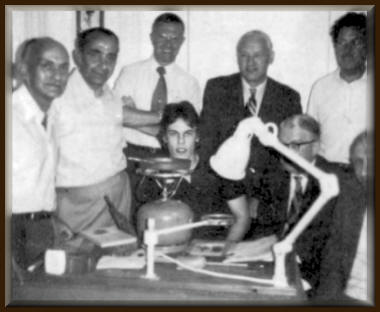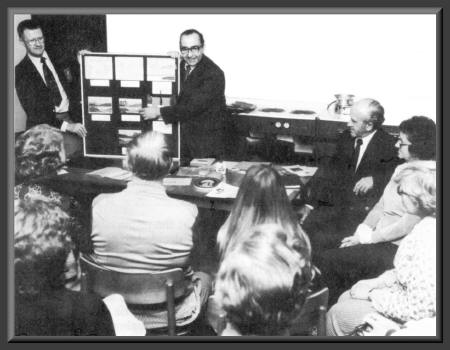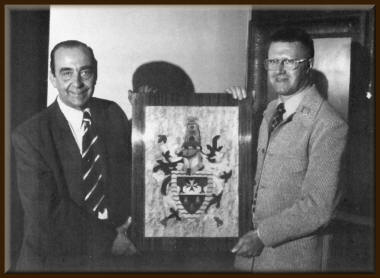|
The
Coat of Arms of the London Borough of Hackney |
|
|
The origins of this article were a piece
written by Derek Austin and Alf Murtell for the Marquetarian in
the early 1970's. The working title was: THE COAT OF ARMS OF THE
LONDON BOROUGH OF HACKNEY
|
|
|
Fred Root volunteered to enlarge the original drawing to a size of approximately 18" x 12½", he also ran off a number of copies of the enlarged drawing. One of these copies was then painted with water colours to give us a guide for the veneers to be used for the project. This was then cut out and pasted onto a sheet of green cardboard. Our original intention was for the background to be Bird's Eye Maple, dyed in a weak solution of Sulphate of Iron, to give a pale greenish colour, this was not a success, as the colour was not right and it also clashed with the other veneers. We had to revert back to a piece of un-dyed Bird's Eye Maple.
Group members then selected the parts they wished to cut, and
these were brought along to meetings in order that comparison
could be made with other sections. No great difficulty was
experienced. The outside mantle was made of Padauk and Sycamore,
with sand scorching where necessary. The Tower consisted of dark
harewood standing on a grass mound. The fragmentation method of
dyed green veneers was used to give this effect. The helmet
consisted of various shades of harewood. The outer shield was in
Sycamore with wavy dyed blue veneers to represent the rivers and
canals flowing through the Borough. The completed parts were then cut into the background veneers, and glued to a piece to a piece of chipboard 15" x 21". This board was then let into a further piece of chipboard 19" x 25" but standing proud by ¼". The outer boards were veneered in Makore. The finish was in Rustin's Plastic Coating. When the plastic coating was applied to the Padauk, this veneer started "bleeding" very badly, and some hasty first aid repairs had to be carried out before it stained the Sycamore. I have never experienced this happening so much to Padauk when I have used it in other pictures I have made. A suitable engraved plate was fixed to the bottom. The Coat of Arms now hangs in the Council Chamber at hackney Town Hall. I would recommend that other Groups attempt this type of combined Marquetry, not necessarily a Coat of Arms, but a picture.All members can participate, even the newest members, even if it means only cutting stringers and borders. The following members helped in the making of this project: K. Daniels, G. Knowles, A.T. Murtell, F. Root, I. Strugnell, D. Austin, D. Townrow, and R. Wiles.  Some of the East London Group team that worked on the Coat of Arms
The members seen in this
photo are, from left to right: |
|
|
A FEW EXTRA NOTES FROM THE EAST LONDON GROUP AT THAT TIME We
have been able to keep an average attendance over the past few
months, and a varied programme. One item that proved of interest
was a model that Fred Root had made from an idea that he had
seen in a hobby magazine many years ago. The basic set up was
similar to a wooden sawing horse: at one end was a small table
which held a piece of paper; the table was mounted on a pivot
and motivated by a pendulum; at the opposite end of the model
was a holder with a felt tip pen, this was also mounted on a
pivot and governed by a pendulum. The pen was placed on the
paper and the two pendulums were set in motion. The swinging of
the two pendulums working in natural harmony produced a design.
By controlling the speed of the pendulum a design was able to be
regulated. Whilst this was not marquetry, I do believe that with
some adjustments to the designs they would be suitable for
geometrical marquetry. (a few further notes concerning the Silver Jubilee mural) All our recent work and meetings has been concerned with the Silver Jubilee panel. It has now been finished and delivered. Some high pressure work starting on December 15th and Shadbolts gluing and sanding on the same day, the addition of an ebony edging around the panel and off to Horwood's of Silvertown for the polishing for two days and finally the photographer. Derek Austin and I (this is the legendary Charlie Good speaking by the way) delivering the finished work on December 22nd to Buckingham Palace. How about that for a week's work?
December 15th:- Our "Three Veneer Competition". Well supported
in the competition. A number of very good pictures entered with
the winners as follows:  Derek & Alf display a demonstration board to a group of marquetry enthusiasts. |
|
|
We hope you have enjoyed reading these historical notes
concerning the original East London Marquetry Group. The notes
were all written in the early 1970's and provide a good insight
into the activities of the group's at the time. They certainly
seemed to be a very active and dedicated bunch of marquetarians
- I hope they would approve of today's efforts - I think they
would! |
|
| Tutorials Menu | |


